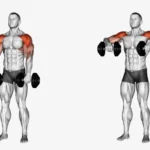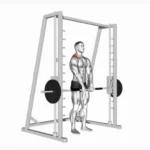Two-Arm Standing Dumbbell Extension: Exercise Overview
The two-arm standing dumbbell extension is a highly effective isolation exercise that targets the triceps, with a particular focus on the long head of the muscle. This variation of the tricep extension is performed standing, using a single dumbbell held with both hands to enhance arm strength and definition. By emphasizing the long head, this exercise helps create a fuller, more pronounced triceps appearance, contributing to an aesthetically balanced upper arm (Schoenfeld, 2010). It’s an excellent choice for those aiming to improve arm aesthetics or boost performance in pressing movements like the bench press or overhead press. The two-arm standing dumbbell extension can be incorporated into arm workouts, upper-body sessions, push routines, or full-body training programs.
How to Perform the Two-Arm Standing Dumbbell Extension
- Select a dumbbell of appropriate weight and stand with your feet shoulder-width apart in an open area.
- Lift the dumbbell to your shoulder, then press it overhead with both hands, overlapping your palms around the handle to secure your grip—this is your starting position.
- Keeping your upper arms stationary and close to your head, slowly lower the dumbbell behind your head by bending your elbows.
- Lower until your forearms are parallel to the floor or slightly below, depending on your range of motion.
- Drive the dumbbell back to the starting position by extending your elbows and contracting your triceps.
- Repeat for the desired number of repetitions.
Tips for Optimal Performance
- Choose the Right Weight: Select a weight that challenges you within your target rep range (e.g., 8–12 for hypertrophy) while allowing you to maintain proper form throughout the set.
- Maintain Core Stability: Engage your abs and glutes to keep your ribcage down and prevent excessive arching of the lower back, which reduces strain on the spine (McGill, 2010).
- Control the Eccentric Phase: Lower the dumbbell slowly to increase time under tension, enhancing muscle activation and improving the mind-muscle connection (Schoenfeld, 2016).
- Keep Head Aligned: Maintain a neutral neck position to avoid forward tilting, which can place undue stress on the cervical spine.
- Focus on Triceps Isolation: Keep your upper arms fixed and move only at the elbows to ensure the triceps, particularly the long head, do the work.
- Breathe Properly: Exhale as you extend the dumbbell upward and inhale as you lower it to support controlled movement and muscle oxygenation.
Building triceps with dumbbell extensions? Learn their role in our Ultimate Guide to Muscle Groups for arm power.







